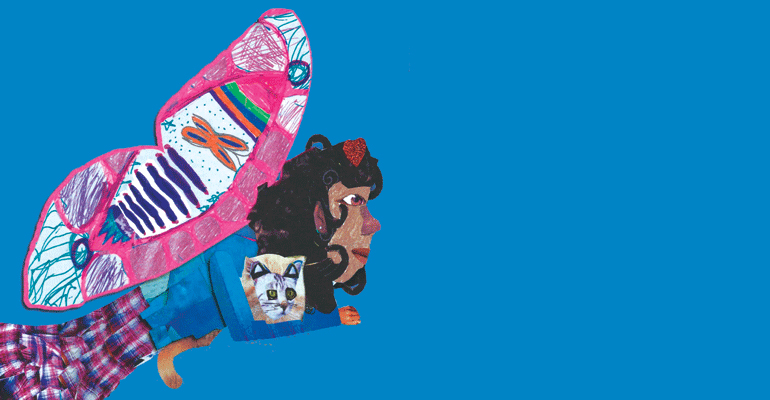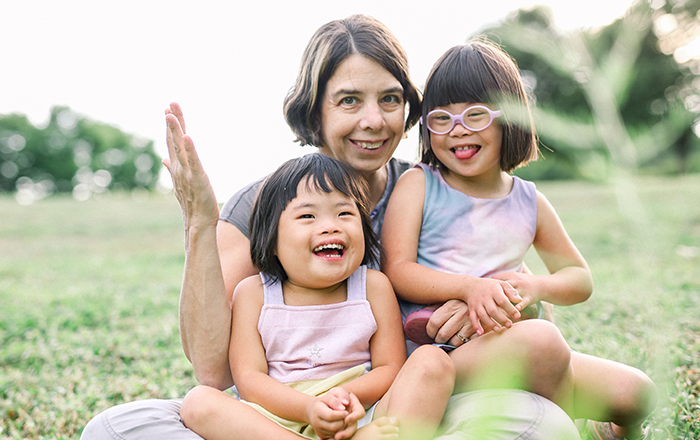Last year, my daughter and I discovered that we had created a book together.
For many years, I’d taught creative writing in New York City public schools. Collaborating with elementary school students on stories and poems taught me how freeing it was for a child to be able to speak through the filter of a fictional self. With the help of good characters, all kinds of tricky truths could be transformed into art.
After I had kids, I found myself sharing that skill, encouraging them to talk by way of stories and illustrations, which became homemade “books” that we read over and over. From a young age, my daughter’s stories centered around the fantastical travels of a fictional girl who was also adopted. We named our character Paloma, after the Spanish word for dove, put wings on her, and let her travel the skies in search of parts of herself.
My daughter suggested directions, like Paloma’s search for birth parents; I listened, and framed the narrative in verse. After I read back what I’d done, my daughter revised. “Too scary to fly away by herself,” she said early on, and then, “Paloma needs a cat for company!” as a solution. We devoted hours to this common (and fun) purpose, finding the right words, cutting and drawing accompanying illustrations in an oversized scrapbook, until we’d brought Paloma’s story to a fitting close. I was so moved by Paloma that I considered continuing a version myself, but this story belonged to both of us. We retired her to a bedroom bookcase.
Gail: What do you remember about starting to make stories about this character?
Mellabella Storytella (my daughter’s pseudonym): I remember that I was little. I think I was three or four when we started. The first story I remember was when she put on wings and she met a pirate family. Pirates are funniest when they say “ARGH!”
Paloma and her mighty wings burst back off of their shelf when I was diagnosed with breast cancer, as my daughter turned six. The feelings provoked by that sense of looming loss warranted extra care and attention, and, through Paloma, we found it. Recuperating, I suddenly had a lot of time, while my daughter suddenly had a resurgent need for reassurance.
We started reworking Paloma’s travels into a narrative collage that satisfied us both. In the process, we realized that our alter egos each had an arc and a distinct role to play — my daughter’s central and heroic, mine supportive but important. We obsessively glued family photos and scraps of paper to the pages until Paloma’s flights looked, to us, as we imagined them.
M: Did you like making this book?
G: I loved making this book, working on it with you. I loved figuring out the next parts of the story and I really loved doing the collage.
M: I loved hearing each other’s thoughts. I think fiction has a mind of its own.
G: Whoa, that’s a grown-up way to say that! I loved hearing your ideas, too, and then letting something new grow out of them.
I was sure, in joining the text to the homemade art, that we’d made something so idiosyncratic that it would be understood only by us. But as we shared Paloma’s journey with clinicians, teachers, and adopted people to whom we went for advice throughout our own journey, it spoke to our readers.
Even more surprising to me than their excited responses (“show us more”) was my daughter’s motivation to share the book. First, she asked to read it to her second-grade class (a classroom that felt particularly inviting to her, with a teacher and several students who were adopted). Then we read to other classes, then to affinity groups to which we belong (for adoptive families, and for families with children of color, not adoption-specific), and, ultimately, as a work of fiction to kids who just liked books.
When a boy in an early audience asked a question that I found to be wincingly personal, I froze. “Have you gone to meet your birth mother?” he asked.
“Disaster!” I thought, “Too many nosy questions….”
My daughter, however, shrugged. “You are asking a question about me,” she reminded him. “But we’re talking about a character in a book. Ask a question about Paloma.”
I took my cues from my daughter — the joy in creation that she showed me, the pride in having made something complex, something eliciting real feedback. I listened to the confidence that it gave her when she told Paloma’s story, while not having to speak about her own biography.
G: So, do you think that there’s a little of you in Paloma, or a lot of you?
M: There’s a medium amount of me, but I’m more like her than not like her. She’s like me because my mom has light skin and my dad and my brother have light skin, and Paloma’s mom, dad, and brother do too. I also like peppermint chip ice cream cones like Paloma does — but for me, vanilla is tied for favorite. I also sometimes imagine that I put on wings and go visit my birth family in Colombia. Paloma is also more a person who says stuff without knowing what it means, like “posilutely, positruly.” I know what things mean. Paloma is still six or maybe seven. She used to be older than me when we first started, but I’m older than she is now. I grew up but she stayed the same.
We titled the book Paloma the Possible, and I self-published it in order to maintain control over our work and to quietly make it available to the people who had asked if they could have a copy. We chose “book names,” (or “Dr. Seuss names,” as my daughter calls them), so that we could test the waters from a distance. I am Gaily Told-Tales; my daughter named herself Mellabella Storytella — and will remain so until she’s old enough to proclaim herself, if she so chooses.
It was not an easy decision to let Paloma fly. Although she is fiction, Paloma is, of course, not far from our experiences; we are always figuring out how to draw a clear line between the two. But we realized that, by letting our character out on her own, she would fly to places where her story would resonate most. The book is slowly making its way into schools and to related service providers. The responses of many families, many teachers and writers, many adoptive parents and kids, have been humbling and powerful.
G: Now that the book is printed, separate from the original that we made, are you excited when you see it in the world? Embarrassed? Proud? How do you feel?
M: Of course it makes me excited to see it because it’s now in regular places. It depends on my mood that day if I want to read it or hear about it, but it’s always good to see it. After this, I’m going to illustrate more books. I don’t know what they’re about yet.
In making the choice to share this work with larger circles of readers, we are hopeful that we can add something meaningful to their lives. Maybe our common experiences can guide future conversations as profound as our experience has been with Paloma.
The last lines of the book, after Paloma has begun the process of claiming and integrating all parts of her identity, are:
“Or maybe I belong to them both.”
Las dos.
All one family.
Paloma is referring to her birth and adoptive families with this quote, but at many of the readings that we’ve done, we ask the audience to paste or draw a picture of their own families onto an “All One Family Community Collage.” The interconnectedness of our lives, our families, and the parts of ourselves has been a guiding theme, and both the processes of creating and now sharing this book have given new meaning to that idea. Paloma the Possible can fly on without us, and we can take the lessons of possibility that we’ve learned from her into our lives.
M: Paloma is about knowing that you don’t have to be exactly like your family if you don’t want to. You don’t have to look the same, think the same way, or like the same things. Your skin color doesn’t have to be the same. And you can always wonder about your birth family or your adopted family or whatever you want. It’s OK.
Paloma the Possible is available by special order from your local bookstore, from the author’s website, gailytoldtales.com, or on amazon.com or bn.com.



